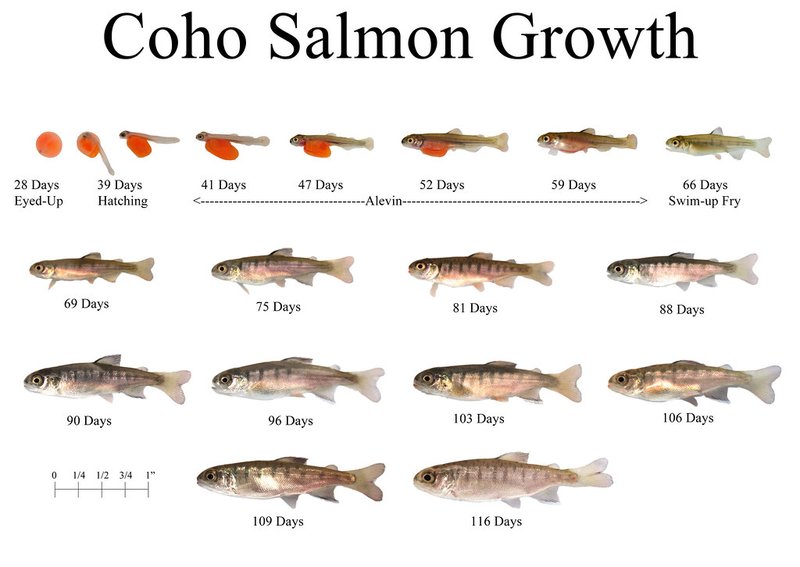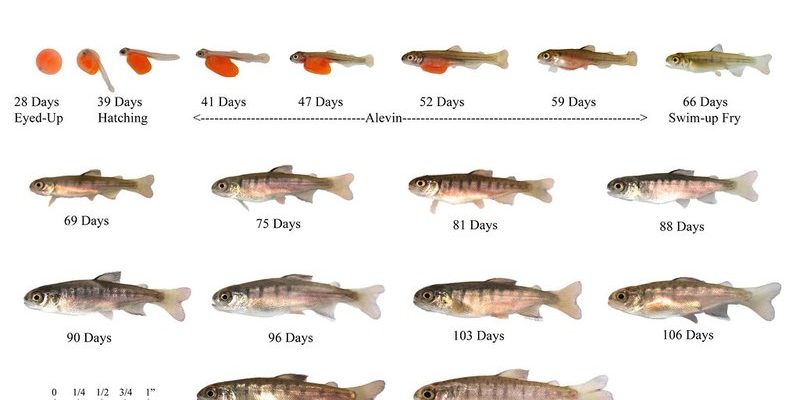
So, let’s dive into the world of salmon growth, explore the different stages of their lives, and understand what factors contribute to their growth rate. Whether you’re a fishing enthusiast or just curious about these incredible fish, you’re in for a treat!
Understanding Salmon Species and Their Growth Rates
Different species of salmon grow at unique rates. The most common types, like Chinook, Coho, and Sockeye salmon, have distinct growth patterns. For instance, Chinook salmon, the largest of the Pacific salmon, can reach impressive sizes of up to 100 pounds! They typically take about 3 to 5 years to mature. On the other hand, Coho salmon usually grow to around 8 to 12 pounds and take about 2 to 3 years to reach maturity.
Here’s a quick breakdown of some popular salmon species and their typical growth rates:
- Chinook Salmon: 3-5 years, up to 100 pounds
- Coho Salmon: 2-3 years, 8-12 pounds
- Sockeye Salmon: 4-5 years, 6-8 pounds
- Pink Salmon: 1-2 years, 3-5 pounds
- Atlantic Salmon: 2-3 years, up to 30 pounds
The differences in growth rates largely come down to habitat, food availability, and water temperature. Naturally, this makes understanding these factors super important for anyone interested in salmon fishing or aquaculture.
Factors Influencing Salmon Growth
Here’s the thing: salmon don’t grow in a vacuum. Several factors influence their growth, with temperature and food availability being two of the most critical.
Temperature plays a big role in the growth of salmon. Warmer waters can speed up metabolism, causing salmon to grow faster. However, if the water gets too warm, it can actually stress the fish and impede growth. Most salmon prefer water temperatures around 55 to 65°F. If you’re fishing, you might notice them thriving in cooler, deeper waters during hot summer months.
Now let’s talk about food. Salmon are opportunistic feeders, meaning they’ll eat whatever’s available. In their early years, they feast on tiny organisms like zooplankton, and as they grow, they switch to larger prey, such as fish. A well-balanced diet rich in nutrients is essential for optimal growth. For instance, if salmon have access to abundant food during their juvenile phase, they’ll likely grow faster.
Juvenile Salmon Growth Stages
Juvenile salmon, also known as fry, go through several stages of growth. After hatching, they remain in freshwater for a year or so before migrating to the ocean. During this time, they rely on their yolk sacs for nutrition, slowly absorbing nutrients until they’re ready to venture out.
Once they reach the smolt stage, they undergo physiological changes to adapt to saltwater. This is a crucial transition, as they need to be ready for life in the ocean. The growth rate during these stages can be rapid, especially with a plentiful food supply. Juvenile salmon can grow from just a few inches to several pounds in a year.
Understanding their growth stages helps in managing their populations and ensuring sustainable fishing practices.
Growth Rates in Captive vs. Wild Environments
When you compare growth rates in wild versus captive environments, the differences can be striking. In the wild, salmon face natural predators, fluctuating food availability, and changing environmental conditions, all of which can slow their growth. In isolated environments like fish farms, salmon can grow faster because they are typically provided with optimal conditions for growth.
Fish farms control multiple factors, such as water temperature, food supply, and even health monitoring, which leads to more consistent growth rates. For example, farmed Atlantic salmon can reach market size in just about 18 to 24 months, compared to wild salmon, which can take significantly longer.
However, there are concerns about the long-term effects of farming on the growth of salmon, including issues like overcrowding and disease. Balancing sustainability and growth is key here.
Monitoring Growth Rates
Whether in the wild or farmed, monitoring growth rates is crucial. Fisheries use various techniques to assess salmon growth. Tagging and tracking methods help scientists understand migration patterns and growth in different environments. Additionally, they analyze factors such as body condition and feeding behavior, which can indicate overall health and growth potential.
For anyone involved in fishing or aquaculture, knowing how to monitor these growth rates can lead to better management practices and sustainability efforts.
Common Misconceptions About Salmon Growth
You might be wondering about some common myths surrounding salmon growth. One of the most prevalent misconceptions is that larger salmon always grow faster. In reality, growth rates can vary widely among individuals, regardless of their size. Certain factors, like genetics and environmental conditions, can influence growth more than sheer size.
Another myth is that all salmon grow quickly once they reach the ocean. While many do experience a growth spurt, some species, especially those in colder waters, might take their time adjusting to the ocean environment before growing quickly.
Recognizing these misconceptions can help anglers and enthusiasts make more informed decisions about salmon fishing or conservation efforts.
The Importance of Growth Rates for Conservation
Conservation efforts heavily rely on understanding salmon growth rates. Knowing how quickly they grow and reproduce helps scientists and policymakers develop sustainable fishing regulations. For instance, if a species is growing slower due to environmental stressors, regulations can be put in place to protect those populations.
Moreover, healthy growth rates are crucial for maintaining balanced ecosystems. Salmon play a pivotal role in many food webs, supporting not just their own species but numerous other creatures, from bears to birds.
Conservationists often focus on habitat restoration and pollution control to ensure salmon populations thrive. By understanding their growth rates, we can better protect these amazing fish and the ecosystems they inhabit.
Wrapping It Up: The Beauty of Salmon Growth
So, how fast do salmon grow? The answer isn’t straightforward—it varies based on species, environment, and food availability. But one thing’s for sure: salmon growth is a fascinating topic that intertwines with ecology, conservation, and even our dining tables.
Whether you’re an avid fisherman or just someone who enjoys nature, understanding how fast salmon grow can deepen your appreciation for these incredible fish. Long story short, next time you savor a delicious salmon dish, remember the journey these fish have taken, from fry to fully-grown adults—it’s quite remarkable!

